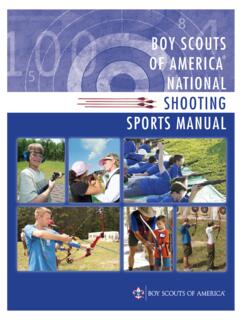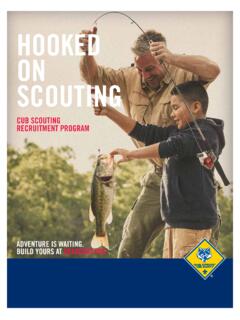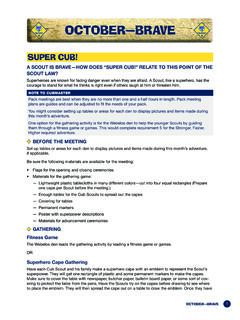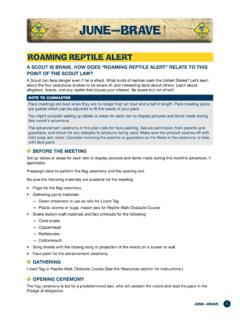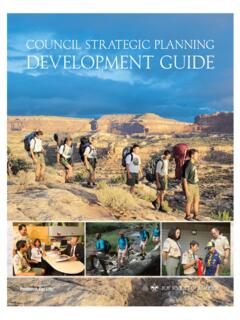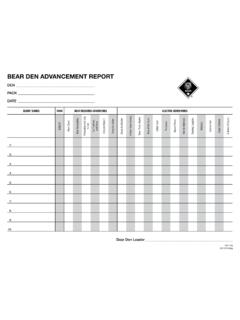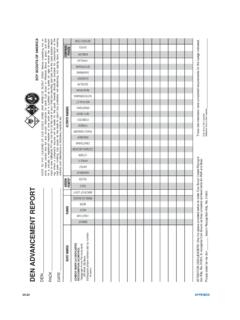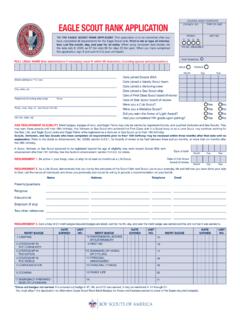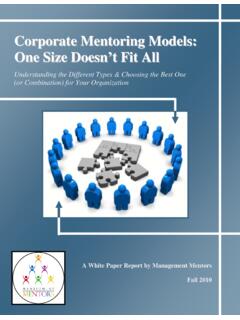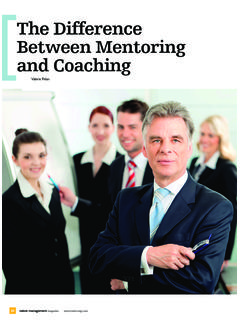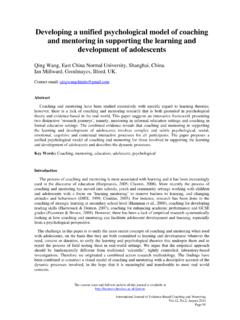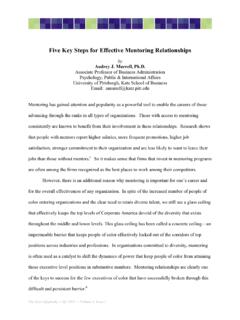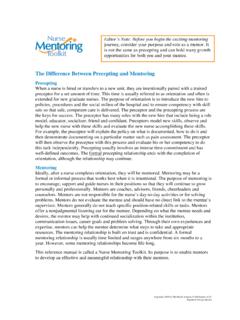Transcription of Mentoring - Boy Scouts of America
1 Mentoring Training Summary Mentoring is an opportunity to help a person grow through discovery. This session will address various Mentoring models and ways to be a mentor to Scouts and Scouters. Time Required 60 minutes Target Audience All Scouters Learning Objectives At the end of the session, participants will have knowledge of: The difference between coaching and Mentoring The Mentoring models of sponsorship and development What is involved in maintaining a quality Mentoring relationship The evolution of a Mentoring relations The elements of a learning conversation The benefits of Mentoring and they will be able to: Select the appropriate Mentoring model for the situations they come across Maintain a quality Mentoring relationship Conduct learning conversations Training Format Lecture Discussion Required Materials Power point slides Projection screen or other surface Laptop computer LCD projector Flip chart or white board Markers Handouts PowerPoint slides, notes version printed three per page Training Resources None Mentoring Self-Introductions (Slide 1) Presenter introduces himself and asks all participants to give their name and volunteer position.
2 What Is a Mentor? (Slide 2) Ask: What is a mentor? List those characteristics as they are given without judgment. Afterwards, state: In the Homer s story The Odyssey, when Odysseus left for the Trojan War, he entrusted Mentor with the guidance and education of his son, Telemachus. The name of Odysseus friend is Mentor. The first recorded modern usage of the term can be traced to a book entitled Les Aventures de Telemaque, by the French writer Fran ois F nelon. In the book, the lead character s name is Mentor. The word mentor comes from the Greek language and has its roots in the terms steadfast and enduring. In Western thought, the term mentor is synonymous with one who is a wise teacher, a guide, a 2 Re-emphasize: A mentor is A wise teacher A guide A friend Is Mentoring Like coaching ?
3 Ask: Is Mentoring and coaching the same thing? One description states that coaching is the process of facilitating the performance, learning, and development of another The coach is responsible for directing and aligning the members of a team to achieve a goal; therefore, the coach is also responsible for leading the development of the team members. coaching is different from Mentoring because the Mentoring process is led by the learner and is less skills-based. A good Mentoring relationship is identified by the willingness and capability of both parties to ask questions, challenge assumptions, and disagree. The mentor is far less likely to have a direct-line relationship with the mentee, and in a Mentoring relationship this distance is desirable.
4 Mentoring is rarely a critical part of an individual s role, but rather an extra element that rewards the mentor with fresh thinking as well as the opportunity to transfer knowledge and experience (wisdom) to a new Show Slide 3. Some key differences between coaching and Mentoring are:4 coaching Mentoring Goals To correct inappropriate behavior, improve performance, and impart skills as an individual accepts a new responsibility To support and guide the personal growth of the mentee Initiative The coach directs the learning and instruction. The mentee is in charge of his or her learning. Focus Immediate problems and learning opportunities Long-term personal development Roles Heavy on telling with appropriate feedback Heavy on listening, providing a role model , and making suggestions and connections Two Types of Mentoring The rest of this session is based on Mentoring in Action: A Practical There are two different models of Mentoring , one is called sponsorship and the other is called developmental.
5 Sponsorship Mentoring is a relationship between a mentor and a prot g , whereas developmental Mentoring is less hierarchal and helps the growth of both the mentor and the mentee. Show Slides 4-7 and review both models. Ask the participants to identify situations in which one model is more appropriate than the other. Examples include: Scoutmaster to an assistant Scoutmaster sponsorship Scoutmaster to senior patrol leader developmental Senior patrol leader to assistant senior patrol leader sponsorship Patrol leader to Scout developmental Cubmaster to den leader developmental Chartered organizational representative to committee chair developmental District executive to district committee member developmental Unit commissioner to crew Advisor developmental The Shape of a Mentoring Relationship The nature of the Mentoring relationship is dynamic, in the sense that it.
6 Will be different according to the circumstances, purpose, and personalities involved Wvolves over time May take and adjust its shape along a spectrum defined by two very different philosophies or models of Mentoring Maintaining Relationship Quality With the Mentoring relationship being dynamic and therefore creating a great deal of variation in how individuals approach their roles; however, there are certain factors that will effect the quality of the relationship. Show Slide 8. Goal clarity There needs to be a sense of purpose to the relationship. The ability to create and manage rapport It is important that there is an alignment of core values between the mentor and mentee, both in terms of initial attraction or liking and in sustaining the relationship over time.
7 However, partnering individuals with too many similarities can cause problems. The rapport-building process encompasses the skills of accepting and valuing difference as a fundamental learning resource. Understanding of the role and its boundaries Clarity must be maintained that the mentor will not assume a directive or managerial role. Voluntarism Both participants have to want to be part of the relationship. Basic competencies on the part of the mentor and mentee Both parties must bring some skills and attributes to the table. The aim should be to improve these skills over time through the learning dialogue. Proactive behaviors by mentee and developmental behaviors by the mentor The mentee needs to take the initiative and the mentor must not be directive.
8 Measurement and review The mentor and mentee need to take time to review the relationship. Having a regular open dialog that focuses on how to improve the relationship is a key factor. Assess how to make the relationship more valuable and reaffirm the commitment. Evolution of Relationship There should be five distinct phases in maintaining a quality Mentoring relationship. This chart shows the relationship of the intensity of learning and value added from a Mentoring relationship over time. Show Slide 9. The five phases are: Phase 1: Building rapport The mentor and the mentee are exploring if they can work together. They are determining the alignment of values, establishing a mutual respect, agreeing on the purpose of their relationship, and establishing the roles and expectations.
9 Phase 2: Setting direction This phase is all about goal setting. Whereas in phase 1, they were establishing a sense of purpose, here they are determining what each of them should achieve through this relationship. Phase 3: Progression This phase is longest of the five. Here the both the mentor and mentee become more comfortable about challenging each other s perceptions, and they explore issues more deeply and experience mutual learning. Also, the mentee takes an increasing lead in managing the relationship and the Mentoring process itself. Phase 4: Winding up This occurs when the mentee has achieved a large amount of his or her goals. The mentee begins to plan how to continue the journey on his or her own. This helps avoid unhealthy dependency on either individual s part.
10 Winding up by celebrating the accomplishments is much better than winding down/drifting apart. Phase 5: Moving on This is about changing the relationship, often into a friendship where both parties can utilize each other as an ad hoc sounding board. Allow for questions and discussion. The Learning Conversation The point of the Mentoring process is to create a reflective environment where the mentee can address various issues. Show Slide 10. To do this, a learning conversation should be used that uses the following steps: Reaffirmation The mentor and mentee spend time to reestablish connectedness using more than just the normal social niceties. In a good relationship, there will be a mutual recognition of emotional states and the level of interest.

